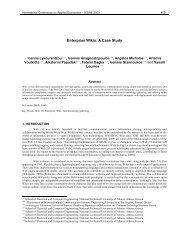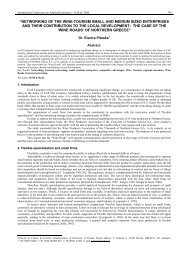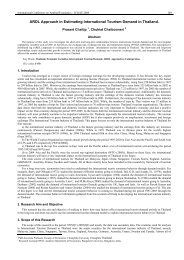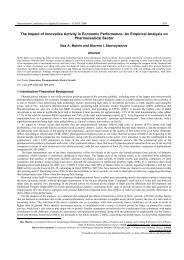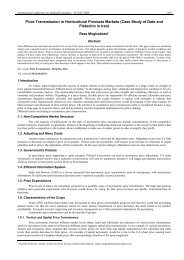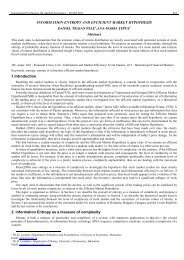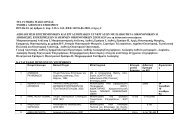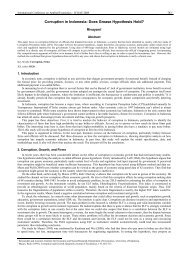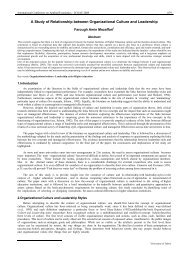Visual Representations in Secondary School Textbooks of Economics
Visual Representations in Secondary School Textbooks of Economics
Visual Representations in Secondary School Textbooks of Economics
You also want an ePaper? Increase the reach of your titles
YUMPU automatically turns print PDFs into web optimized ePapers that Google loves.
International Conference on Applied <strong>Economics</strong> – ICOAE 2008 321<br />
<strong>Visual</strong> <strong>Representations</strong> <strong>in</strong> <strong>Secondary</strong> <strong>School</strong> <strong>Textbooks</strong> <strong>of</strong> <strong>Economics</strong><br />
Demetra Fotakopoulou 1 & Vasiliki Spiliotopoulou 2<br />
Abstract<br />
Our research is concerned with the visual representations found <strong>in</strong> textbooks used for the teach<strong>in</strong>g <strong>of</strong> <strong>Economics</strong> <strong>in</strong> Greek secondary schools. Initially, we<br />
analyze and reflect upon the visual <strong>in</strong>terpretations <strong>of</strong> the textbook that is taught <strong>in</strong> the first year <strong>of</strong> upper <strong>Secondary</strong> education (Greek Lyceum). A scheme<br />
<strong>of</strong> categories <strong>of</strong> visual representations has been identified and reveals the characteristics <strong>of</strong> the textbooks’ representations as well as their limitations. We<br />
also explore students’ experiences with two visual representations <strong>of</strong> this textbook. Evidence, regard<strong>in</strong>g the features <strong>of</strong> these visual representations that<br />
attract students’ attention, which emerges from the answers that students provide, is discussed. Students seem to face serious difficulties <strong>in</strong> read<strong>in</strong>g the<br />
mean<strong>in</strong>g <strong>of</strong> the visual representations, even when the <strong>in</strong>formation is there. It seems that it is difficult for an image on its own to express a thousand words.<br />
This issue is related to both authors who write the textbooks and teachers who are teach<strong>in</strong>g their scientific content.<br />
Key Words: <strong>Visual</strong> representations <strong>of</strong> economics, <strong>Economics</strong> Education, <strong>School</strong> textbooks <strong>of</strong> <strong>Economics</strong><br />
JEL codes: A210<br />
1. Introduction<br />
The subject <strong>of</strong> economics has been a part <strong>of</strong> the Greek higher general secondary school curriculum for around 20 years. It aims to<br />
<strong>of</strong>fer a general awareness <strong>of</strong> the economic ideas and their mean<strong>in</strong>g for the personal and social life. The teach<strong>in</strong>g and learn<strong>in</strong>g <strong>of</strong><br />
economics, however, <strong>in</strong> Greece has not attracted attention and takes place <strong>in</strong> a rather personal and lonely way, as the field <strong>of</strong> economics<br />
education has not been developed yet. On the other hand societal needs require economically literate citizens and such a perspective<br />
raises issues concern<strong>in</strong>g the way economics is taught rather as a path to scientific certa<strong>in</strong>ty, than as reflect<strong>in</strong>g unsettled debate and<br />
vigorous controversy (Editorial Introduction <strong>of</strong> Australasian Journal <strong>of</strong> <strong>Economics</strong> Education).<br />
<strong>Secondary</strong> school teach<strong>in</strong>g and learn<strong>in</strong>g is dom<strong>in</strong>ated by textbook-oriented approaches (Tob<strong>in</strong>, 1990) and this is also the case <strong>in</strong><br />
Greece. The subject <strong>of</strong> economics is ma<strong>in</strong>ly taught <strong>in</strong> a traditional manner, just as any other subject, based ma<strong>in</strong>ly on textbooks.<br />
Curriculum materials play an important role <strong>in</strong> students’ learn<strong>in</strong>g. Pyne (2007) found that the <strong>in</strong>troductory microeconomics textbook <strong>of</strong><br />
an economic course had significant and sizeable effects on student performance. In a study by Asano (2006) it was found that first-year<br />
students showed confusion <strong>in</strong> apply<strong>in</strong>g marg<strong>in</strong>al analysis to a firm’s pr<strong>of</strong>it maximization problem, which stemmed from textbooks for the<br />
<strong>in</strong>troductory microeconomics course oversimplify<strong>in</strong>g the relevant subtle po<strong>in</strong>ts.<br />
Efforts have begun to develop an adequately valid and reliable procedure <strong>in</strong> order to judge whether or how well, curriculum materials<br />
match specific learn<strong>in</strong>g goals (AAAS – Project 2061, 2006). The content <strong>of</strong> the curriculum and subsequently textbooks’ content has<br />
ma<strong>in</strong>ly been the focus <strong>of</strong> different studies (Dittmer, 2005). Although visual representations (VR) <strong>in</strong> textbooks are important teach<strong>in</strong>g and<br />
learn<strong>in</strong>g tools only recently have attracted research attention. The focus <strong>of</strong> this study is the visual representations <strong>in</strong>volved <strong>in</strong> a secondary<br />
school textbook <strong>of</strong> economics and the students’ read<strong>in</strong>gs for two <strong>of</strong> them.<br />
1.1. Rationale<br />
In many discipl<strong>in</strong>es, ideas are expressed <strong>in</strong> the form <strong>of</strong> draw<strong>in</strong>gs, diagrams, charts and graphs. These visual representations can vary<br />
from quick <strong>in</strong>formal sketches to carefully considered formal render<strong>in</strong>gs. Whatever their orig<strong>in</strong> and form, such graphic artefacts help<br />
people to th<strong>in</strong>k about their ideas and to communicate those ideas to others. <strong>Visual</strong> representations are also essential <strong>in</strong> communicat<strong>in</strong>g<br />
ideas <strong>in</strong> classrooms; however, the design <strong>of</strong> such representations is not always beneficial for learners. Such considerations have been<br />
<strong>in</strong>vestigated plac<strong>in</strong>g emphasis not only on the cognitive architecture, but to <strong>in</strong>dividual differences and prior knowledge (Cook, 2006).<br />
The co-deployment <strong>of</strong> written language and visual representations is especially important for textbooks which aim to lead non-expert<br />
readers to an understand<strong>in</strong>g <strong>of</strong> the esoteric doma<strong>in</strong> <strong>of</strong> a scientific field. Regard<strong>in</strong>g science textbooks, Koulaidis & Dimopoulos (2005/06)<br />
suggest that they “should ideally be authored <strong>in</strong> such a way so as to privilege converg<strong>in</strong>g and <strong>in</strong>tentional <strong>in</strong>terpretations on the part <strong>of</strong> the<br />
learners while discourag<strong>in</strong>g divergent and un<strong>in</strong>tentional read<strong>in</strong>gs”.<br />
Vision is central to our biological and socio-cultural be<strong>in</strong>g. The faculty <strong>of</strong> vision is our most important source <strong>of</strong> <strong>in</strong>formation about<br />
the world (Adams & Victor, 1993). As for the socio-cultural aspect, it is almost a commonplace to state that we live <strong>in</strong> a world where<br />
<strong>in</strong>formation is transmitted mostly <strong>in</strong> visual wrapp<strong>in</strong>gs, and technologies support and encourage communication which is essentially<br />
visual. Therefore, as biological and as socio-cultural be<strong>in</strong>gs, we are encouraged and aspire to ‘see’ not only what comes ‘with<strong>in</strong> site’, but<br />
also what we are unable to see (Arcavi, 2003). Thus one way <strong>of</strong> characteriz<strong>in</strong>g visualization and its importance, both as a ‘noun’ – the<br />
product, the visual image – and as a ‘verb’ – the process, the activity (Bishop, 1989), is that visualization <strong>of</strong>fers a method <strong>of</strong> see<strong>in</strong>g the<br />
unseen. Tak<strong>in</strong>g <strong>in</strong>to account that most <strong>of</strong> the entities and functions <strong>in</strong> the subject <strong>of</strong> economics are abstract and not possible to be seen,<br />
the visual representations can play a central role <strong>in</strong> the teach<strong>in</strong>g and learn<strong>in</strong>g <strong>of</strong> economics, as visualization is no longer related to<br />
illustrative purposes only. It is also be<strong>in</strong>g recognized as a key component <strong>of</strong> reason<strong>in</strong>g (deeply engag<strong>in</strong>g with the conceptual and not the<br />
merely perceptual), problem solv<strong>in</strong>g and even predict<strong>in</strong>g. There are so many issues concern<strong>in</strong>g visualization <strong>in</strong> economics education<br />
which require careful attention. In this study, we focus on visual representations used <strong>in</strong> higher secondary classrooms. <strong>Visual</strong>ization, as<br />
both the product and the process <strong>of</strong> creation, <strong>in</strong>terpretation and reflection upon pictures and images, is considered to be here very<br />
important, as although we deal with economical factors every day, the process <strong>of</strong> understand<strong>in</strong>g economical ideas <strong>in</strong> a more abstract and<br />
scientific way is a demand<strong>in</strong>g task. More particularly, our research questions are:<br />
• What k<strong>in</strong>d <strong>of</strong> visual representations (VR) are commonly used to portray ideas <strong>of</strong> economics <strong>in</strong> the school textbook <strong>of</strong> the first<br />
year <strong>of</strong> Lyceum?<br />
1<br />
Teacher <strong>of</strong> <strong>Economics</strong>, General Department <strong>of</strong> Education, <strong>School</strong> <strong>of</strong> Pedagogical and Technological Education (A.S.PE.T.E.) – Division <strong>of</strong> Patras,<br />
Achaikis Sympoliteias 20, Zavlani, 26442, Patras, Greece, email:<br />
2<br />
Pr<strong>of</strong>essor <strong>of</strong> Science and Technology Education, General Department <strong>of</strong> Education, <strong>School</strong> <strong>of</strong> Pedagogical and Technological Education (A.S.PE.T.E.) –<br />
Division <strong>of</strong> Patras, Achaikis Sympoliteias 20, Zavlani, 26442, Patras, Greece, email: spiliot@otenet.gr
322<br />
• Whaat<br />
choices do auuthors<br />
make <strong>in</strong> select<strong>in</strong>g or connstruct<strong>in</strong>g<br />
these e images?<br />
• Whaat<br />
is students’ reead<strong>in</strong>g<br />
<strong>of</strong> these two representaations<br />
and what do they show tto<br />
us?<br />
2. Methodoology<br />
The study <strong>in</strong>volves two p<br />
title <strong>of</strong> the boook<br />
is ‘Pr<strong>in</strong>cipl<br />
fourth grade o<strong>of</strong><br />
secondary sc<br />
focused on stuudents’<br />
experien<br />
not followed bby<br />
analytical lab<br />
The first rrepresentation<br />
national accouunts’.<br />
The VR h<br />
l<strong>in</strong>es, at the topp<br />
left, stand the<br />
The seconnd<br />
representation<br />
It has the folloow<strong>in</strong>g<br />
head<strong>in</strong>g:<br />
top, is followeed<br />
by the terms<br />
last one. The ffirst<br />
<strong>in</strong>cludes, a<br />
the month Octtober,<br />
is also <strong>in</strong><br />
where advertiss<strong>in</strong>g<br />
campaign i<br />
The researrch<br />
tool consiste<br />
first question asked students<br />
set <strong>of</strong> questionns,<br />
students ha<br />
question.<br />
58 studentts<br />
<strong>of</strong> the 4<br />
tasks. All stud<br />
had also been<br />
th , 5 th<br />
phases. In the fiirst<br />
we analyzed<br />
the visual rep presentations <strong>of</strong>f<br />
a secondary scchool<br />
textbook <strong>of</strong> economics. The<br />
es <strong>of</strong> Economiics’<br />
(Dedousopoulos,<br />
Gialeris,<br />
Shistou, Tenttes<br />
& Chatziandreou,<br />
2002) and a is taught <strong>in</strong>n<br />
the<br />
chools that meeans<br />
the first yeear<br />
<strong>of</strong> upper se econdary schoool,<br />
the Greek LLyceum.<br />
In the second phase, , we<br />
nces with two o<strong>of</strong><br />
these visual rrepresentations<br />
(Figure 1 and 2). Both repressentations<br />
were coloured and wwere<br />
bels.<br />
(Figure 1) is <strong>in</strong>nvolved<br />
<strong>in</strong> the text <strong>of</strong> a unit with subtitle ‘NNational<br />
produuct’<br />
under the title t ‘The levells<br />
<strong>of</strong><br />
had the follow<strong>in</strong>ng<br />
head<strong>in</strong>g: ‘Thhe<br />
growth rate <strong>of</strong> o Gross Nationnal<br />
Product <strong>of</strong> GGreece-EEC’.<br />
The T signs <strong>of</strong> the two<br />
e first one for GGreece<br />
and the ssecond<br />
one for EEC. E<br />
n (Figure 2) is i<strong>in</strong>volved<br />
<strong>in</strong> the text <strong>of</strong> a small unit with the tiitle<br />
‘The meanss<br />
for the satisfac ction <strong>of</strong> our neeeds’.<br />
‘Advertis<strong>in</strong>g eexpenses<br />
<strong>of</strong> Octtober<br />
(1997-199 98)’. In each <strong>in</strong>stance<br />
<strong>of</strong> the VVR,<br />
the sign <strong>of</strong> the t rectangle, att<br />
the<br />
‘TELEVISIONN’<br />
<strong>in</strong> the first, ‘ ‘MAGAZINES S’ <strong>in</strong> the secondd,<br />
‘JOURNALSS’<br />
<strong>in</strong> the third an nd ‘RADIO’ <strong>in</strong>n<br />
the<br />
lso, the word <strong>in</strong>n<br />
italics ‘Percenntage<br />
%’, while e <strong>in</strong> the diaries <strong>of</strong> all four <strong>in</strong>staances<br />
the abbreviation<br />
‘OCT.’ , for<br />
nvolved. It seemms<br />
that the authhors<br />
aimed to relate r it to the ‘ Goods’ for the consumption and a for the growwth,<br />
is allocated.<br />
ed <strong>of</strong> two pagess,<br />
each one <strong>of</strong> wwhich<br />
<strong>in</strong>volved a visual representation<br />
and a nnumber<br />
<strong>of</strong> relev vant questions. The<br />
to describe thee<br />
content <strong>of</strong> eacch<br />
VR and wha at they thought each representaation<br />
aims to sh how. In the seccond<br />
ad to read <strong>in</strong>forrmation<br />
that waas<br />
<strong>in</strong>volved <strong>in</strong> the VR. In thiis<br />
work we anaalyze<br />
systematically<br />
only the first<br />
h th<br />
and 6 grade that means thee<br />
three years <strong>of</strong> f Greek Lyceumm<br />
worked aboutt<br />
a school sessi ion work<strong>in</strong>g onn<br />
the<br />
dents have beenn<br />
taught the conntent<br />
<strong>of</strong> the bookk.<br />
The research h took place <strong>in</strong> AApril<br />
and so stuudents<br />
<strong>of</strong> the first<br />
year <strong>of</strong> Lyceum<br />
taught the unitss<br />
with the VR aand<br />
a considerabble<br />
time had pa assed s<strong>in</strong>ce thenn.<br />
Figure 1: VR <strong>of</strong> the growwth<br />
rate <strong>of</strong> G.NN.P.<br />
<strong>of</strong> Greecee-EEC<br />
For thee<br />
analysis <strong>in</strong> bboth<br />
phases we employed the approach <strong>of</strong> <strong>in</strong> nductive categoory<br />
developmeent<br />
<strong>of</strong> qualitativ ve content anallysis<br />
(Mayr<strong>in</strong>g, 20000).<br />
In this apprroach,<br />
it is <strong>of</strong> ceentral<br />
<strong>in</strong>terest too<br />
develop the as spects <strong>of</strong> <strong>in</strong>terppretation,<br />
the caategories,<br />
as nea ar as possible too<br />
the<br />
material, to foormulate<br />
them <strong>in</strong> terms <strong>of</strong> thee<br />
content <strong>of</strong> the<br />
material under<br />
analysis. Ouur<br />
unit <strong>of</strong> analyysis,<br />
namely, th he fragment thaat<br />
is<br />
categorized eaach<br />
time, is eacch<br />
visual repressentation<br />
with tthe<br />
accompany y<strong>in</strong>g label <strong>in</strong> rellation<br />
also to thhe<br />
relevant text t <strong>in</strong> the first phhase,<br />
while <strong>in</strong> the seecond<br />
is each paart<br />
<strong>of</strong> a student’ ’s answer that sshows<br />
a dimens sion <strong>of</strong> his experience.<br />
Figure 2: VR <strong>of</strong> the advertis<strong>in</strong>g<br />
expenses o<strong>of</strong><br />
October (19997-1998)<br />
International CConference<br />
on AApplied<br />
Econom mics – ICOAE 22008<br />
The produuced<br />
categorizattions,<br />
<strong>in</strong> the forrm<br />
<strong>of</strong> systemic nnetworks<br />
(Bliss s et al, 1983), wwere<br />
validated bby<br />
three researc chers, <strong>of</strong> whom two<br />
were economists,<br />
teachers <strong>in</strong> secondary schoool<br />
and one wass<br />
a science educ cator.<br />
3. Analysiss<br />
3.1. Phase 1: <strong>Visual</strong> reepresentatioons<br />
<strong>of</strong> schoool<br />
textbook<br />
3.1.1. The caategorisationn<br />
Initially thhe<br />
number <strong>of</strong> VVR<br />
has been coounted.<br />
85 VR hhave<br />
been foun nd over 198 pagges<br />
that results <strong>in</strong> 0.43 VR pe er page. Pages wwith<br />
questions, exeercises<br />
and prooblems<br />
for studdents’<br />
practice have been excluded.<br />
This meeans<br />
that VR <strong>in</strong>n<br />
the book <strong>of</strong> economics are not<br />
favourable esppecially<br />
when ccompar<strong>in</strong>g<br />
withh<br />
the results fouund<br />
from the VR V <strong>of</strong> Biology aand<br />
Chemistry books, where each page contta<strong>in</strong>s<br />
more than twoo<br />
VR (Amariotaakis,<br />
2007). 60% % <strong>of</strong> the VR arre<br />
not followed by labels or anny<br />
comments <strong>in</strong>nside<br />
the repres sentation. Then, , the<br />
corpus <strong>of</strong> VR has been studieed<br />
and a numbeer<br />
<strong>of</strong> dimensionns<br />
have been ide entified presentted<br />
<strong>in</strong> the systemmic<br />
network <strong>of</strong> f Figure 3. So, eeach<br />
VR is categorrized<br />
accord<strong>in</strong>gg<br />
the type it is, the relation too<br />
the content, the relation too<br />
reality, and iits<br />
function wit th<strong>in</strong> the text <strong>of</strong>f<br />
the
International Conference on Applied <strong>Economics</strong> – ICOAE 2008 323<br />
page. In terms <strong>of</strong> type, VR<br />
<strong>Visual</strong><br />
representations<br />
Type<br />
Relation to the<br />
content<br />
Relation to<br />
reality<br />
Function<br />
Image<br />
Diagrammatic<br />
Sketch - Comic<br />
Clip & scrap<br />
Photograph<br />
Absent - Weak<br />
A k<strong>in</strong>d <strong>of</strong> relationship<br />
Mean<strong>in</strong>gful for learn<strong>in</strong>g<br />
Realistic representation<br />
Conceptual map<br />
can be categorized as image when they are sketch-comic, clip & scrap, photograph, or as diagrammatic type like table, graph,<br />
schematic representation or conceptual map. In terms <strong>of</strong> relation to the content, a VR can have no relation or a very weak relevance to the<br />
content, can have some k<strong>in</strong>d <strong>of</strong> relationship, or can be mean<strong>in</strong>gful for the learn<strong>in</strong>g <strong>of</strong> the content. In terms <strong>of</strong> their relationship with<br />
reality, VRep can be also classified as realistic, when they try to express aspects <strong>of</strong> a reality, or as metaphorical, when they connote or<br />
symbolize mean<strong>in</strong>gs over what they represent. F<strong>in</strong>ally, a VR has a function <strong>in</strong> terms <strong>of</strong> learner’s read<strong>in</strong>g (Spiliotopoulou, Karatrantou,<br />
Panagiotakopoulos & Koustourakis, 2008). In this case, as decorative are counted the ones that are not <strong>in</strong>tended to play a role <strong>in</strong> learn<strong>in</strong>g,<br />
but to make the page more beautiful or <strong>in</strong>terest<strong>in</strong>g, or give only a general aesthetic sense or feel<strong>in</strong>g <strong>of</strong> the textual spirit. As illustrative<br />
can be characterized the VRep, that provide simple representations <strong>of</strong> entities discussed <strong>in</strong> the text, without add<strong>in</strong>g mean<strong>in</strong>g or<br />
<strong>in</strong>formation <strong>in</strong> the textual reference. Sometimes, an illustrative VRep can prove to be more useful than def<strong>in</strong>itions for giv<strong>in</strong>g the<br />
mean<strong>in</strong>gs <strong>of</strong> words. Exemplify<strong>in</strong>g VRep are the ones that are suitable as completed examples or a variety <strong>of</strong> <strong>in</strong>stances related to the<br />
entities or concepts the written language refers to. VRep function as complementary when they provide <strong>in</strong>formation not <strong>in</strong>cluded and<br />
described explicitly <strong>in</strong> the l<strong>in</strong>guistic component.<br />
Sometimes they highlight the most important po<strong>in</strong>ts addressed <strong>in</strong> the text or extend the <strong>in</strong>formation <strong>of</strong> the text <strong>in</strong> richness or <strong>in</strong> new<br />
fields, thus contribut<strong>in</strong>g to the completion <strong>of</strong> the <strong>in</strong>tended new knowledge. In the category <strong>of</strong> explanatory VRep fall the ones that assist<br />
the text and provide new aspects <strong>of</strong> <strong>in</strong>formation necessary to make the explanatory, conceptual or causal mechanisms under<br />
consideration, clearer.<br />
Table<br />
Graph<br />
Metaphorical representation<br />
Decorative<br />
Illustrative<br />
Exemplify<strong>in</strong>g<br />
Explanatory<br />
Complementary<br />
Schematic representation<br />
Figure 3: The systemic network with dimensions and categories <strong>of</strong> VR
324<br />
Characteriistic<br />
examples aare<br />
shown <strong>in</strong> Fiigures<br />
4, 5 & 6. More analytica ally, <strong>in</strong> Figure 44,<br />
the VR preseented<br />
is a photograph<br />
<strong>in</strong>cluded <strong>in</strong> a<br />
unit about formms<br />
<strong>of</strong> markets and the way thhat<br />
prices are shhaped.<br />
It has a metaphorical ssense<br />
and its coonnection<br />
with the content is vvery<br />
weak, while itts<br />
role is rather decorative. In FFigure<br />
5, the VRR<br />
presented is <strong>in</strong>volved i <strong>in</strong> a unnit<br />
with the titlee<br />
“Needs and desires”. d Its headd<strong>in</strong>g<br />
says: ‘The deevelopment<br />
<strong>of</strong> pprivate<br />
cars’ oownership<br />
per 1.000 <strong>in</strong>habitan nts <strong>in</strong> Athens’. . At the left boottom<br />
side, the e axis is namedd<br />
as<br />
‘Veehicles<br />
/ 1.000 <strong>in</strong>h.’, while <strong>in</strong>n<br />
the<br />
blacck<br />
horizontal bar the tterm<br />
‘Preedictions’<br />
is written. w Inside the<br />
grapph,<br />
there is s the notattion:<br />
“Deevelopment<br />
<strong>of</strong> f property <strong>in</strong>ndex<br />
19996<br />
- 2020 83% %’. Authors’ aim<br />
seemms<br />
to be the e relation <strong>of</strong> this<br />
reprresentation<br />
to t the relaative<br />
diffferentiation<br />
betw ween the conccepts<br />
<strong>of</strong> thhe<br />
economic need<br />
and the desire.<br />
It iss<br />
categorized as a a graph, it hhas<br />
a<br />
k<strong>in</strong>dd<br />
<strong>of</strong> relationsh hip to the conntent<br />
andd<br />
it has a ra ather exemplify fy<strong>in</strong>g<br />
nature.<br />
Photograpphs<br />
<strong>of</strong> fold<strong>in</strong>g mmoney<br />
are conssidered<br />
to havee<br />
an illustrative function. A chharacteristic<br />
exaample<br />
<strong>of</strong> a com mplementary VVR<br />
is<br />
presented <strong>in</strong> FFigure<br />
6. The uunit<br />
has a title: : “The econommic<br />
system <strong>in</strong> crisis’.<br />
The barss<br />
<strong>in</strong> the graph correspond to the three levells<br />
<strong>of</strong><br />
educationn,<br />
signed at th he bottom by the square symmbols,<br />
the firs st stand<strong>in</strong>g for the<br />
‘Primary education’, the e second for thee<br />
‘<strong>Secondary</strong> edducation’<br />
and th he third for ‘Higgher<br />
educationn’.<br />
In the hor rizontal axis, tthe<br />
countries o<strong>of</strong><br />
Europe are e located with the<br />
follow<strong>in</strong>gg<br />
sequence: Austria, A Portuggal,<br />
Greece, HHolland,<br />
Italy, Belgium, Britta<strong>in</strong>,<br />
Germanyy,<br />
Sweden, Fran nce, Denmark, Ireland, Spa<strong>in</strong>, , F<strong>in</strong>land. At th he right bottomm<br />
the<br />
source <strong>of</strong><br />
the <strong>in</strong>formation<br />
is notated: : ‘Source: Euroopean<br />
Commis ssion (1996)’. The<br />
graph hass<br />
a head<strong>in</strong>g ‘Un nemployment aand<br />
Level <strong>of</strong> Edducation’,<br />
which h is not <strong>in</strong>volveed<br />
<strong>in</strong><br />
the VR aas<br />
appears <strong>in</strong> Figure<br />
6. There iis<br />
no relevant ddescription<br />
<strong>in</strong> th he unit, but this VR<br />
<strong>of</strong>fers to the reader mo ore <strong>in</strong>formation relevant to thee<br />
content <strong>of</strong> th he curriculum, sso<br />
it<br />
functionss<br />
complementar ry to the text.<br />
3.1.2. F<strong>in</strong>d<strong>in</strong>ngs<br />
Table 1 prresents<br />
the frequuencies<br />
<strong>of</strong> categories<br />
<strong>of</strong> VRepp<br />
that are met <strong>in</strong> n secondary texxtbooks.<br />
As is sshown,<br />
more th han half <strong>of</strong> themm<br />
are<br />
photographs (554%),<br />
while almmost<br />
one third <strong>of</strong> them are diffferent<br />
k<strong>in</strong>d <strong>of</strong> diagrams d (27.3%)<br />
and 14.2% tables. 11.3% <strong>of</strong> o them are skeetch-<br />
comics and a tthere<br />
are few (33.2%)<br />
clips and scraps form neewspapers<br />
or ma agaz<strong>in</strong>es.<br />
Tablle<br />
1: Percentagges<br />
<strong>of</strong> VR per ccategory<br />
Typee<br />
<strong>of</strong> representaation<br />
Sketcch-comic<br />
Clip & scrap<br />
Photoograph<br />
Tablee<br />
Graph<br />
- Diagram<br />
Schemmatic<br />
representtation<br />
Concceptual<br />
map<br />
Relattion<br />
to the conntent<br />
<strong>of</strong> text<br />
Abseent<br />
- weak<br />
A k<strong>in</strong>nd<br />
<strong>of</strong> relationshhip<br />
Meann<strong>in</strong>gful<br />
for learnn<strong>in</strong>g<br />
Relattion<br />
to reality<br />
Realiistic<br />
Metaaphorical<br />
Funcction<br />
Decoorative<br />
Illusttrative<br />
Exemmplify<strong>in</strong>g<br />
Percentage<br />
(%)<br />
11,3<br />
3.2<br />
54<br />
14.5<br />
4.8<br />
12.5<br />
10<br />
12.9<br />
45.16<br />
46.7<br />
49.41<br />
50.58<br />
52,94<br />
8,23<br />
31,17<br />
International CConference<br />
on AApplied<br />
Econom mics – ICOAE 22008
International Conference on Applied <strong>Economics</strong> – ICOAE 2008 325<br />
Explanatory 8,23<br />
Complementary 9,41<br />
Less than half <strong>of</strong> VR can be considered as mean<strong>in</strong>gful for the learn<strong>in</strong>g <strong>of</strong> the text content, while there are some VR (12.9%) that are<br />
not related at all or are related <strong>in</strong> a very weak way to the mean<strong>in</strong>g <strong>of</strong> the content. Half <strong>of</strong> the VR are realistic and the other half<br />
metaphorical. Half <strong>of</strong> VR have a decorative function, while 31.17% are exemplify<strong>in</strong>g ones. A percentage <strong>of</strong> 8.23% VR are illustrative<br />
and another 8.23% only are explanatory, while 9.41% can be considered as complementary.<br />
3.2. Phase 2: Students’ experiences with the two VR<br />
The first question asked students to read each VR carefully and then to write a description <strong>of</strong> what they thought the VR is about and<br />
what aims to show.<br />
Categories emerged from students’ experiences with the first VR are presented <strong>in</strong> Figure 7. Two dimensions have been identified:<br />
The concept where students’ attention has focused and the characteristics <strong>of</strong> the language used for the description. As it appears <strong>in</strong> Table<br />
2, 33.9% <strong>of</strong> the students did not manage to provide a description. In terms <strong>of</strong> concepts, 25% mention the terms ‘rate’ or ‘growth rate’,<br />
53.57% describe <strong>in</strong> terms <strong>of</strong> Greece and EEC, while there is a small percentage 3.4 that refer only to Greece. 16.07 <strong>of</strong> the students refer<br />
to the concept <strong>of</strong> development and only 33.92%<br />
Students’<br />
descriptions<br />
Concept<br />
Characteristics <strong>of</strong><br />
description<br />
Growth rate<br />
G.N.P. <strong>of</strong> Greece-EEC<br />
G.N.P. <strong>of</strong> Greece<br />
Development<br />
Time<br />
Personal Description<br />
Enriched description<br />
Other book concepts<br />
Information <strong>of</strong> VR<br />
General<br />
Twenty years<br />
Other periods<br />
Figure 7: The systemic network <strong>of</strong> the categories <strong>of</strong> descriptions for the ‘G.N.P.’<br />
VR<br />
paid attention to the factor <strong>of</strong> time, 7.14% <strong>of</strong> them referred to it <strong>in</strong> a general way, while 16.07% only mentioned the period <strong>of</strong> twenty<br />
years and 10,71% referred to other periods. Their descriptions, <strong>in</strong> 17.86% <strong>of</strong> the cases, can be characterized as personal, e.g. “The growth<br />
rate <strong>of</strong> a sector”, <strong>in</strong> 25% they used terms similar the ones <strong>in</strong>volved <strong>in</strong> the VR, <strong>in</strong> 7.14% they mentioned other concepts from their book<br />
and only <strong>in</strong> 16.07% students gave enriched descriptions, where further expla<strong>in</strong>ed the VR not necessarily <strong>in</strong> the best way. Such an<br />
example is the follow<strong>in</strong>g: “The diagrammatic representation has as goal to present the growth rate <strong>of</strong> different <strong>in</strong>dustries and <strong>in</strong> extent <strong>of</strong><br />
the different products before and after the entrance <strong>of</strong> Greece <strong>in</strong> EEC”.<br />
Table 2: Percentages <strong>of</strong> categories for the G.N.P. VR<br />
Categories Percentage (%)<br />
No answer 33.9<br />
Focus on concepts<br />
Growth rate 25<br />
G.N.P. <strong>of</strong> Greece 3.4<br />
G.N.P. Greece-ΕΕC 53.57<br />
Development 16.07<br />
General 7.14<br />
Time Twenty years 16.07<br />
Other periods 10.71<br />
Characteristics <strong>of</strong> descriptions<br />
Personal description 17.86<br />
Enriched description 16,07<br />
Other book concepts 7.14
326 International Conference on Applied <strong>Economics</strong> – ICOAE 2008<br />
Information <strong>of</strong> VR 25<br />
Categories emerged from students’ descriptions for the second VR (Figure 2) are presented <strong>in</strong> the systemic network <strong>of</strong> Figure 8. One<br />
<strong>of</strong> the concepts <strong>in</strong> the VR on which students focused is the advertis<strong>in</strong>g expenses with some talk<strong>in</strong>g about them <strong>in</strong> general. They may also<br />
refer to the variation <strong>of</strong> expenses per k<strong>in</strong>d <strong>of</strong> media, to the time and to the concept <strong>of</strong> percentage. Another concept is media. Aga<strong>in</strong> some<br />
students may refer to them <strong>in</strong> general, but some others describe more analytically referr<strong>in</strong>g to the four k<strong>in</strong>ds <strong>of</strong> media represented, or to<br />
the social role <strong>of</strong> them. A characteristic example <strong>of</strong> the last category is a student’s description: “It wants to show the effect <strong>of</strong> media on<br />
people’s life”.<br />
Time also is a concept which is mentioned <strong>in</strong> students’ comments. The month October <strong>in</strong>volved <strong>in</strong> the head<strong>in</strong>g <strong>of</strong> the VR is<br />
sometimes perceived and referred <strong>in</strong> their descriptions, while the period 1997-1998 is a dom<strong>in</strong>ant idea as we will see. Time without<br />
specification is also mentioned.<br />
Study<strong>in</strong>g students’ descriptions we identified some other characteristics related to the way <strong>of</strong> their talk<strong>in</strong>g about the VR. So, they can<br />
be dist<strong>in</strong>guished as personal descriptions, enriched descriptions and descriptions <strong>in</strong>clud<strong>in</strong>g distant to the ma<strong>in</strong> <strong>in</strong>tention <strong>of</strong> the VR<br />
concepts. A characteristic example <strong>of</strong> the last category is the follow<strong>in</strong>g: “In this Advertis<strong>in</strong>g Expense, which published <strong>in</strong> October 1997-<br />
98, we see that a research took place about how people get <strong>in</strong>formed. We see that the ma<strong>in</strong> <strong>in</strong>form<strong>in</strong>g is taken by the Television”. This<br />
student has mis<strong>in</strong>terpreted the mean<strong>in</strong>g <strong>of</strong> the VR and thought its mean<strong>in</strong>g to be about how people get <strong>in</strong>formed. Another case is when<br />
use <strong>in</strong> their descriptions similar <strong>in</strong>formation to the ones existed as textual <strong>in</strong>formation <strong>in</strong> the VR. A characteristic example is the<br />
follow<strong>in</strong>g: “It wants to show the advertis<strong>in</strong>g expense that was made the October (1997-1998) <strong>in</strong> the different k<strong>in</strong>ds <strong>of</strong> media”.<br />
Students’<br />
descriptions<br />
Concepts Media 4 k<strong>in</strong>ds<br />
Social role<br />
Month<br />
Time<br />
Period 1997-98<br />
General<br />
Characteristics <strong>of</strong><br />
descriptions<br />
Advertis<strong>in</strong>g expenses<br />
General<br />
Personal Description<br />
Enriched description<br />
Distant concepts<br />
Information <strong>of</strong> VR<br />
General<br />
Variation per<br />
k<strong>in</strong>d <strong>of</strong> media<br />
Variation <strong>in</strong> time<br />
Percentage<br />
Figure 8: The systemic network with the categories <strong>of</strong> descriptions for the<br />
“Advertis<strong>in</strong>g expenses’ VR<br />
It is worth mentioned some students’ misread<strong>in</strong>g <strong>of</strong> the notion <strong>of</strong> advertis<strong>in</strong>g expenses. The follow<strong>in</strong>g description reveals one<br />
student’s idea that advertis<strong>in</strong>g expenses is about how much money the media spend for their own advertisement: “It shows the variation<br />
<strong>of</strong> the expenses <strong>of</strong> the different k<strong>in</strong>d <strong>of</strong> media. It wants to show that TV has dom<strong>in</strong>ated and does not need the same advertisement as<br />
before <strong>in</strong> contrast to other k<strong>in</strong>ds <strong>of</strong> media that must be advertised more <strong>in</strong> order to ga<strong>in</strong> their old glamour”. This VR did not prove to be<br />
much easier for the students than the first one. As it appears <strong>in</strong> the Table 3, 26.78% <strong>of</strong> the students also did not manage to provide a short<br />
description <strong>of</strong> its content. Only <strong>in</strong> the 14.28% <strong>of</strong> their answers talked about advertis<strong>in</strong>g expenses <strong>in</strong> terms <strong>of</strong> variations per each k<strong>in</strong>d <strong>of</strong><br />
media and only the 8.93% <strong>in</strong> terms <strong>of</strong> variation <strong>in</strong> time. Some students mentioned about media <strong>in</strong> general (17.86%), while only 17.86%<br />
<strong>of</strong> them have referred to all four k<strong>in</strong>ds <strong>of</strong> media <strong>in</strong>volved <strong>in</strong> the VR. Another percentage <strong>of</strong> their descriptions (17.86%) focused on the<br />
social role <strong>of</strong> media, while most <strong>of</strong> them had a different mean<strong>in</strong>g that the <strong>in</strong>tended. In less than half <strong>of</strong> the descriptions the time was<br />
mentioned, while only <strong>in</strong> 8.93% <strong>of</strong> them the month October was noticed. 33.93% <strong>of</strong> them referred to the period 1997-1998 and 5.36% to<br />
time <strong>in</strong> general. 25% <strong>of</strong> the answers had the character <strong>of</strong> a personal description, 10.71% can be characterized as enriched description,<br />
while 23.21% <strong>of</strong> them used terms and <strong>in</strong>formation <strong>in</strong>cluded <strong>in</strong> the textual content <strong>of</strong> the VR and 14.28% referred to concepts distant from<br />
the context <strong>of</strong> VR. It is noticeable that no answer could be characterized as satisfactory <strong>in</strong> reply<strong>in</strong>g the question posed and understand<strong>in</strong>g<br />
the conceptual and contextual framework <strong>of</strong> the VR<br />
.
International Conference on Applied <strong>Economics</strong> – ICOAE 2008 327<br />
Table 3: Percentages <strong>of</strong> categories for the ‘Advertis<strong>in</strong>g Expenses’ VR<br />
Categories Percentage (%)<br />
No answer 26.78<br />
Focus on concepts<br />
Advertis<strong>in</strong>g General 23.21<br />
expenses Variation per medium 14.28<br />
Variation <strong>in</strong> time 8.93<br />
Percentage 16.07<br />
General 17.86<br />
Media<br />
Four k<strong>in</strong>ds 17.86<br />
Social role 17.86<br />
October 8.93<br />
Time<br />
Period 1997-98 33.93<br />
General 5.36<br />
Characteristics <strong>of</strong> descriptions<br />
Personal description 25<br />
Enriched description 10.71<br />
Distant concepts 14.28<br />
Information <strong>of</strong> VR 23.21<br />
4. Conclusions<br />
The f<strong>in</strong>d<strong>in</strong>gs presented here support the need to <strong>in</strong>vestigate the role <strong>of</strong> <strong>Visual</strong> <strong>Representations</strong> <strong>in</strong> teach<strong>in</strong>g and learn<strong>in</strong>g and especially<br />
the teach<strong>in</strong>g and learn<strong>in</strong>g <strong>of</strong> curriculum subjects, like the <strong>Economics</strong>, which most <strong>of</strong> them are beyond students’ immediate experience.<br />
The first part <strong>of</strong> this work focused on the visual representations <strong>in</strong>cluded <strong>in</strong> the book <strong>of</strong> <strong>Economics</strong> <strong>of</strong> the first year <strong>of</strong> Greek Lyceum. It<br />
was found that the ma<strong>in</strong> type <strong>of</strong> visual representation is the photographs (54%), that only half <strong>of</strong> all can be considered as mean<strong>in</strong>gful for<br />
learn<strong>in</strong>g and that half <strong>of</strong> them have a metaphorical role. Moreover, most <strong>of</strong> VR have either a decorative function (52.94%) or an<br />
exemplify<strong>in</strong>g function (31.17%). Tak<strong>in</strong>g <strong>in</strong>to account the facts that no VR is mentioned or notified <strong>in</strong>side the text and that they are not<br />
accompanied by explanatory labels, we can conclude that the visualization <strong>of</strong> the ideas <strong>of</strong> economics is not supported. Their relationship<br />
to the content is not direct and their role as be<strong>in</strong>g a key component <strong>of</strong> the way reason<strong>in</strong>g is developed <strong>in</strong> the discipl<strong>in</strong>e <strong>of</strong> economics is<br />
poor. Although most <strong>of</strong> the VR have a quality <strong>in</strong> terms <strong>of</strong> their technical and aesthetic characteristics, they do not succeed to provide<br />
images <strong>of</strong> the activities and the processes taken place <strong>in</strong> the field <strong>of</strong> economics.<br />
All these highlight the important issue <strong>of</strong> selection <strong>of</strong> fruitful representations. It could be argued that the authors’ rationale <strong>in</strong> the<br />
selection <strong>of</strong> the VR has not a clear goal, neither follows clear direction. It seems that more attention is paid to what is written <strong>in</strong> the<br />
textbook than how this can be better visually presented and better visualised by the readers. On the other hand, the VR from the reader’s<br />
po<strong>in</strong>t <strong>of</strong> view is another important issue that is neglected; the phenomenology <strong>of</strong> the representation imposes certa<strong>in</strong> features and<br />
consequent ideas on students’ read<strong>in</strong>g and <strong>in</strong>terpretations which the authors or the teachers would never have thought about.<br />
This is also supported by evidence from the second part <strong>of</strong> this work on how students experience two <strong>of</strong> these VR, when used<br />
without any textual supplement. Students face serious problems <strong>in</strong> read<strong>in</strong>g, understand<strong>in</strong>g the mean<strong>in</strong>g and describ<strong>in</strong>g what the VR says.<br />
In an effort to generalize the f<strong>in</strong>d<strong>in</strong>gs from the two representations, we can say that students’ experiences have certa<strong>in</strong> characteristics:<br />
The content and the conceptual mean<strong>in</strong>g <strong>of</strong> a VR is not automatically recognized, certa<strong>in</strong> phenomenological aspects <strong>of</strong> the VR attract<br />
their attention, while other quite obvious are neglected, aspects irrelevant to the VR can be recognized, un<strong>in</strong>tended and unexpected<br />
read<strong>in</strong>gs take <strong>of</strong>ten place. Our research raises questions about what k<strong>in</strong>d <strong>of</strong> representations <strong>in</strong> the textbooks <strong>of</strong> <strong>Economics</strong> could be worth<br />
<strong>of</strong> a thousand words. Three directions have to be further exploited: the <strong>in</strong>quiry <strong>of</strong> fruitful representations, the students’ responses to them,<br />
and teachers’ use <strong>of</strong> the VR <strong>in</strong> the classrooms. The importance <strong>of</strong> appropriate teach<strong>in</strong>g materials cannot be doubted, and VR have to f<strong>in</strong>d<br />
their place as a medium that helps students transcend the limitations <strong>of</strong> the m<strong>in</strong>d. Appropriate classroom practices where read<strong>in</strong>g and<br />
<strong>in</strong>terpretation <strong>of</strong> ‘good’ VR need well focused teachers’ actions. Teachers’ <strong>in</strong>terventions relat<strong>in</strong>g to different k<strong>in</strong>ds <strong>of</strong> representations and<br />
oral explanations supplementary to the visual and textual <strong>in</strong>formation have to a priority <strong>in</strong> order pictures to be worth <strong>of</strong> a thousand words.<br />
References<br />
AAAS-Project 2061 (2006), ‘Identify<strong>in</strong>g Curriculum Materials for Science Literacy: A Project 2061 Evaluation Tool’, Available<br />
onl<strong>in</strong>e: http://www.project2061.org/publications/articles/roseman/roseman2.htm, [retrieved on October 31, 2006.<br />
Adams,R.D. - Victor,M. (1993), Pr<strong>in</strong>ciples <strong>of</strong> Neurology, Fifth edition, New York: McGraw-Hill.<br />
Amariotakis,V. (2007), <strong>Visual</strong> representations <strong>of</strong> microcosm <strong>in</strong> Lower <strong>Secondary</strong> school textbooks <strong>of</strong> Biology and Chemistry and<br />
students’ experiences, Unpublished M.Sc. Thesis, Department <strong>of</strong> Primary Education, University <strong>of</strong> Patras.
328 International Conference on Applied <strong>Economics</strong> – ICOAE 2008<br />
Arcavi,A. (2003), ‘The Role <strong>of</strong> <strong>Visual</strong> <strong>Representations</strong> <strong>in</strong> the Learn<strong>in</strong>g <strong>of</strong> Mathematics’, Educational Studies <strong>in</strong> Mathematics, 52,<br />
215-241.<br />
Asano,A. (2006), ‘Teach<strong>in</strong>g marg<strong>in</strong>al analysis: on the importance <strong>of</strong> emphasiz<strong>in</strong>g the second-order condition’,<br />
International Review <strong>of</strong> <strong>Economics</strong> Education, 5(1): 48-59.<br />
Bishop,A. (1989), ‘Review <strong>of</strong> research <strong>in</strong> visualization <strong>in</strong> mathematics education’, Focus on Learn<strong>in</strong>g Problems <strong>in</strong><br />
Mathematics, 11(1), 7-16.<br />
Bliss,J. - Monk,M. - Ogborn,J. (1983), Qualitative Data Analysis for Educational Research, Croom Helm: London.<br />
Cook,M.P. (2006), ‘<strong>Visual</strong> representations <strong>in</strong> science education: The <strong>in</strong>fluence <strong>of</strong> prior knowledge and cognitive load theory on<br />
<strong>in</strong>structional design pr<strong>in</strong>ciples’, Science Education, 90, 1073-1091.<br />
Dedousopoulos,A.- Gialeris,P. - Schistou,I. - Tentes,P - Chatziandreou,A. (2002, 3 rd edition), Pr<strong>in</strong>ciples <strong>of</strong> <strong>Economics</strong>, OEDB:<br />
Athens.<br />
Dittmer,T. (2005), ‘Dim<strong>in</strong>ish<strong>in</strong>g Marg<strong>in</strong>al Utility <strong>in</strong> <strong>Economics</strong> <strong>Textbooks</strong>’, Journal <strong>of</strong> Economic Education, 36(4):<br />
391-399.<br />
Koulaidis,V. - Dimopoulos,K. (2005/06), ‘The Co-deployment <strong>of</strong> <strong>Visual</strong> <strong>Representations</strong> and Written Language as Resources for<br />
Mean<strong>in</strong>g Mak<strong>in</strong>g <strong>in</strong> Greek Primary <strong>School</strong> Science <strong>Textbooks</strong>’, International Journal <strong>of</strong> Learn<strong>in</strong>g, 12(10): 243-254.<br />
Mayr<strong>in</strong>g, P. (2000, June), ‘Qualitative Content Analysis’ [28 paragraphs], Forum Qualitative Sozialforschung / Forum: Qualitative<br />
Social Research [On-l<strong>in</strong>e Journal], 1(2), Available onl<strong>in</strong>e: http://www.qualitative-research.net/fqs-texte/2-00/2-00mayr<strong>in</strong>g-e.htm<br />
[retrieved on December 11, 2006].<br />
Pyne, D. (2007), ‘Does the Choice <strong>of</strong> Introductory Microeconomics Textbook Matter?’, Journal <strong>of</strong> Economic Education, 38(3): 279-<br />
296.<br />
Spiliotopoulou,V. - Karatrantou,A. - Panagiotakopoulos,C. - Koustourakis,G. (2007), ‘<strong>Visual</strong> <strong>Representations</strong> <strong>of</strong> the Internet <strong>in</strong><br />
Greek <strong>School</strong> <strong>Textbooks</strong> and Students’ Experiences’, been submitted.<br />
Tob<strong>in</strong>,K. (1990), ‘Research on science laboratory activities: In pursuit <strong>of</strong> better questions and answers to improve learn<strong>in</strong>g’, <strong>School</strong><br />
Science and Mathematics, 90: 403-418.



